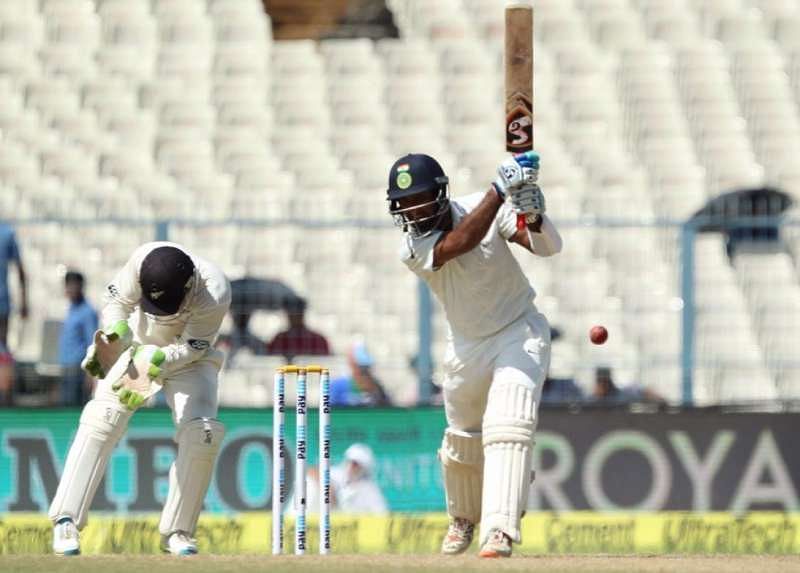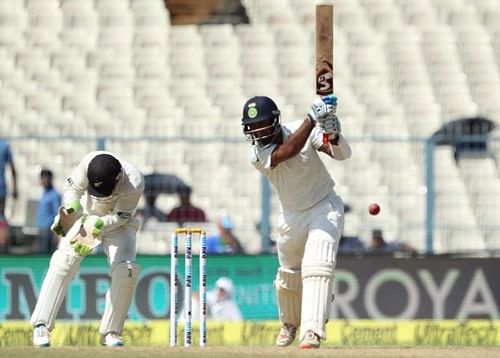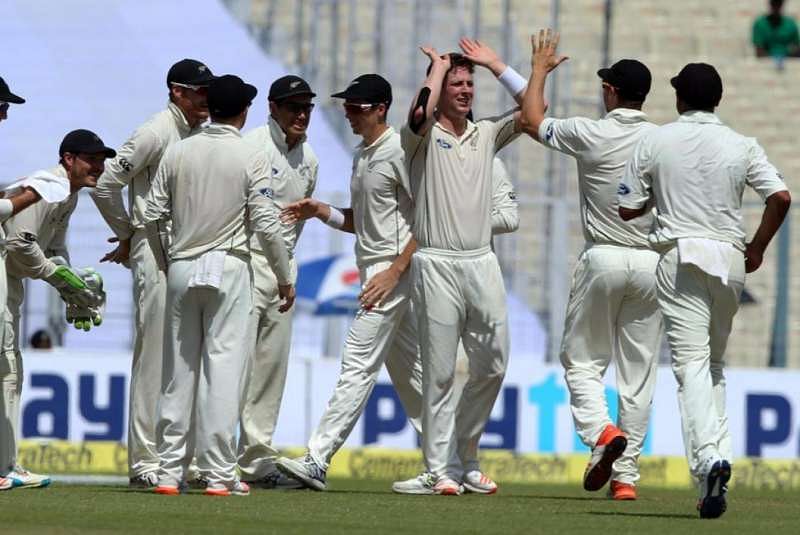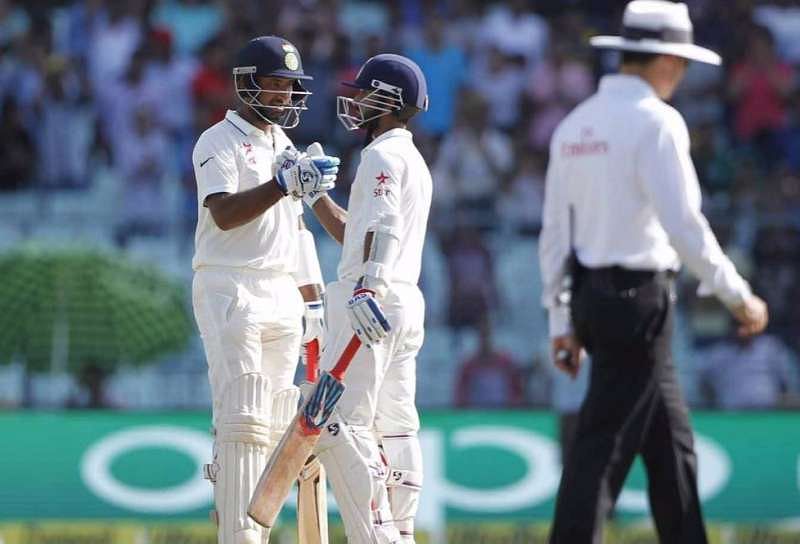
Cheteshwar Pujara schools fellow batsmen on the art of test batting

The second match of the India vs New Zealand test series got off to a shaky start for the Indians after winning the toss and electing to bat first. The Eden Gardens wicket had a greenish tinge to it and offered plenty of bounce and carry for the faster bowlers in the earlier part of the day.
New Zealand decided to go in with an extra fast bowler dropping the average Ish Sodhi for express bowler Matt Henry. Captain Kane Williamson had to sit out due to a bug and Henry Nicholls was included in the playing XI.
The Indians also made a couple of changes with Shikhar Dhawan coming in for the injured KL Rahul and Bhuvaneshwar Kumar given a chance in place of Umesh Yadav.
Poor start for India
It turned out to be a great morning for the Kiwis and the incoming Henry as he got both the Indian opening batsmen cheaply very early in the innings with some brilliant fast bowling. Shikhar Dhawan (1) chopped on to the wickets, trying to play with an angled bat.
Pujara walked in much earlier than he would have anticipated and he showed his confidence and form by getting off the mark with a boundary through the leg side off Henry. He followed it up with an even more impressive drive between the bowler and mid-off.
He was looking comfortable, solid in defence and confident on the attack, playing a couple of glorious cover drives.
Vijay (9) was hanging on at the other end before Matt Henry got him to edge one behind and Watling made no mistake. It was a wonderful piece of bowling from Henry, going wider of the crease and angling it in, bowling it full, making sure Vijay had to play. The ball straightened, getting a thick outside edge to the wicket-keeper.
Suddenly India were in a spot of bother at 28/2. Pujara, at this stage was batting on 17, with four boundaries in his innings. With the Kiwis on top, Virat Kohli came in to the centre. He was looking to make an impact after failures in both innings at Kanpur.
Kohli looked fidgety from the start, with Neil Wagner peppering him with some short stuff. After hanging about for a while, he ended up slicing a ball from Trent Boult to Tom Latham at gully. The ball was wide and should have been left alone but the Indian captain went after it and paid the ultimate price.
He made 9 runs off 28 balls with a “strike-rate” of 28.15.

Pujara at the other end was looking solid against a disciplined period of bowling from the Black Caps. He was not allowed to rotate the strike with some tight fielding, the bowlers were bowling some testing lines and lengths. Mitchell Santner continued his impressive performance from the Kanpur test match as he kept a lid on the runs. Jeetan Patel almost got him out with a brilliant delivery that bounced, got an edge, but went between the keeper and the first slip, to the boundary.
But Pujara hung on as lunch came with India at 46 for 3; Pujara unbeaten on 31, Rahane on 2.
Pujara capitalises after lunch
The Saurashtrian didn’t waste much time after lunch, though, as batting got a little easier with the ball getting older and the bowlers tiring a little. Pujara struck a few more boundaries, delightful flicks through the leg side, pleasing drives through the cover, punches off the back-foot, and was looking at home on a tricky surface.
He respected the good balls, waited for the loose one and when it came, made sure he sent it packing to the boundary. He reached his fifty with a four through the gully area off a Wagner climbing delivery.
Rahane, looking a little suspect with his footwork early in his innings, also kicked on and together, they added 79 runs in the second session as India went to tea with the score at 136 for 3. 79 runs from 31 overs with no more casualties. Surely India’s session.
Soon after play resumed after tea, Rahane reached his fifty. Credit should be given to him for the way he batted after looking a little edgy at the start.
They took the attack to the Kiwi bowlers in the final session with boundaries coming regularly. The run rate in the initial parts of the final session shot up to 3.39. It was a low 2.11 in the first session, and 2.54 in the second session showing that these two batsmen, Pujara, in particular, had batted sensibly. He made sure there was no loss of wicket before lunch, consolidated in the post-lunch session and absolutely cut loose after tea.
As L Sivaramakrishnan put it aptly in commentary, “Survive the first session, grind the second, and score in the third”.
Pujara, nearing his century, looked to drive a full pitched Wagner delivery through the covers, but ended up hitting it in the air and was caught at short cover on 87. India at this stage were on 187 for four. He was obviously disappointed, missing out on a century again after two fifties in the first match. But he had done a good job, playing an innings that pulled his team out of trouble, an innings he can be proud of.
Solid effort by India’s No.3 batsman

Pujara was a model of concentration throughout the day, playing a near chanceless innings. He looked comfortable against both pace and spin. He also left well against the pacers, used his feet well against the spinners, made good use of the depth of the crease, rocking back whenever the ball was on the shorter side.
He showed good technique both in defence and while on the attack and held the innings together at a crucial stage when another wicket would have meant Kiwis would be completely on top.
Pujara did not allow that to happen, showing respect to the bowlers when it was due and along the way making sure he punished the loose balls.
He went on the offensive after tea, putting the Kiwis under some serious pressure. It just goes on to show how important it is to wait for your opportunities and pick key moments. He could not go on to score a big hundred though, which will be the only blemish in this innings for Pujara.
India ended the day’s play on 239 for 7, adding just 52 runs for the loss of three wickets once Pujara was dismissed.
The Saurashtra batsman has been criticised for playing slow at times, but his critics should realise that Test cricket is not always about quick runs. The conditions were difficult earlier in the day and he made sure he hung around, unlike a few of his fellow batsmen, and capitalised once the conditions eased out.
It was an innings of the highest level by Pujara and depicted truly the art of Test match batting.